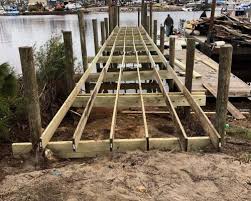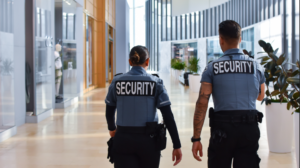Building a dock can be a complex process that involves many factors and water conditions. However, with proper design and materials, a new dock can last for years to come.

Water-resistant decking materials are crucial, as they will repel moisture and prevent rot. Pressure-treated wood offers a natural appearance, while composite or aluminum are lighter and more durable. Visit Our Website Here to learn more.
Stationary docks, also known as fixed docks, rest atop the lake bed and are secured by anchors or weights. This type of dock can withstand strong winds and fluctuating water levels, making it a good choice for choppy or stormy areas. This style of dock is often used for residential properties, but commercial sites are also ideal for stationary piers that connect to boat lifts and create a safe spot for launching or retrieving boats.
When deciding between stationary piers or floating docks, it’s important to look at the conditions of your property and determine which type is right for you. While stationary docks can be great for many waterfront sites, they can also be unstable and difficult to maintain. This is because the foundation of stationary piers lies beneath the surface of the water, with pilings that have to be long and strong enough to support the structure’s weight.
Over time, these pilings can become weak or corroded from the elements and from ice and water movement. This can result in the structure shifting, which requires frequent maintenance to prevent problems. In addition, the wood or concrete that make up the foundation of a stationary dock can also deteriorate and splinter, leading to costly repairs.
In comparison, floating docks are more adaptable and can accommodate a wide variety of water conditions. They can be constructed with materials like HDPE cubes that are easy to move and reconfigure. This makes them a versatile option that can be used for many purposes and is especially popular for recreational boating.
However, floating docks can be susceptible to water debris and algae buildup, which requires regular cleaning and maintenance. They also tend to be less stable than stationary piers and may not be suitable for sites with a changing lake water level or tide. That said, they can be a great choice for high-traffic areas or for those who don’t want to invest in permanent docks. They are also a great option for those who prefer to hop on and off their watercrafts rather than entering them from a dock platform.
Floating Docks
Floating docks set themselves apart from stationary docks by offering the ability to adapt to water level changes. This flexibility makes them popular in marinas and residential waterfront properties. Typically constructed of sturdy materials like aluminum and steel, floating docks can accommodate a wide range of recreational activities and provide easy access to boats and other watercrafts.
Generally, floating docks are built with modular cubes or blocks that are interlocked to create a stable platform on the water’s surface. This modular design allows for a wide variety of shapes and sizes to suit specific docking needs. They also tend to be lightweight and portable, making them easy to move around the water’s edge without the need for specialized equipment.
In addition to their convenience, floating docks are known for their durability and low maintenance requirements. They are also more cost-effective than fixed docks in the long run, as they can be relocated or reconfigured easily to address changing conditions. Moreover, floating docks can be installed in less time than fixed ones, and they don’t require the use of heavy equipment or extensive construction work.
One of the most important factors to consider when choosing a floating dock is its location. Ideally, it should be located in an area that experiences consistent changes in water levels and tides. If not, the dock might experience significant damage or become unusable over time. To avoid this, it’s best to visit the site of your future floating dock and observe the tides, boat traffic, and other factors.
Floating docks can be constructed of many different materials, including wood and aluminum. While wood is a traditional choice for dock building, it can be difficult to maintain over time, especially in a marine environment. In such cases, floating docks made of aluminum or other durable materials can offer better longevity and are ideal for those who want a sturdy structure that can withstand the elements.
Piers
A custom dock is a major investment and can add thousands of dollars in value to your waterfront property. But more than that, it can offer an ideal space for recreation, a private retreat and much more. That’s why it’s important to plan your dock carefully. Before you start building, familiarize yourself with local regulations and permits that may influence the size and placement of your dock.
A fixed dock is typically attached to a lake bed via steel pilings or wooden cribs filled with rocks. Unlike floating docks, this type of dock is stable and durable. It’s ideal for homeowners, recreational users and businesses like marinas that need heavy boat traffic or added amenities.
When planning your dock, make sure to consider the area’s natural water conditions, including stability and depth. Rivers are often highly fluctuating due to tidal variations, rainfall and seasonal changes. To accommodate these fluctuations, a floating dock is a great choice because it can float on unstable silty, muddy or rocky beds.
Floating dock pontoons are usually made from HDPE (high-density polyethylene), which is strong enough to withstand harsh winter conditions. This material is also resistant to rot, warping and pests, which reduces maintenance needs and costs. It’s an excellent choice for homeowners who want to avoid the hassle of removing their dock from the water during the wintertime.
While it’s possible to construct a boat dock yourself, hiring a professional is the best way to ensure that your new structure will stand up to the elements and provide years of enjoyment. A professional can help you select the right materials, design and accessories to create a dock that will suit your specific waterfront needs. They can also help you navigate any permit or zoning requirements that might apply to your project.
The precise positioning of a dock’s pilings is critical to its structural integrity and safety. Taking into account factors like water depth, soil conditions and tidal variation, experienced professionals use a methodical approach to ensure that your dock’s foundation is perfectly positioned for maximum durability and stability.
Wharfs
A dock is a man-made structure that extends from the shore over water to provide a place for boats to be moored or tied up. It may also serve as a recreational area for swimming or other water sports. Many different types of docks exist, ranging in size and complexity, but they all have the same basic function. For example, a private dock is used for mooring and loading boats, while a commercial or public pier is often built on a trestle bridge that reaches over the water.
A quay wall dock is similar to a wharf in that it runs parallel to the shoreline and provides berthing space for ships. However, whereas a wharf is designed to accommodate specific cargo and passenger traffic, a quay is intended for overall operational efficiency in a port or harbor. Specifically, a quay is often designed to handle large cargo volumes, and it may be equipped with additional cargo-handling infrastructure like cranes or warehouses.
As the term “dock” is used differently across North America, it’s important to note that docks are sometimes referred to as piers or wharves. Although these structures perform the same basic functions, they have different aesthetics and are built in different ways. It’s essential to use the proper terminology when describing a docking facility, so that you can get the best construction and maintenance for your waterfront property.
When building a dock, you’ll want to consider how it will be maintained and what type of insects are likely to bother it. For instance, if your dock is made of wood, you’ll need to take precautions against pests such as powerpost beetles and carpenter ants. You can prevent these insects from damaging your dock by regularly inspecting it for infestations, and applying insecticide or other treatments as necessary.
It’s also important to remember that your dock must be adequately sheltered from the elements. You may need to add a retaining wall or breakwater, and you should plan for any dredging required to maintain a safe water depth. Additionally, a floating dock should be protected by a barrier from prevailing winds and waves to avoid tripping hazards.








